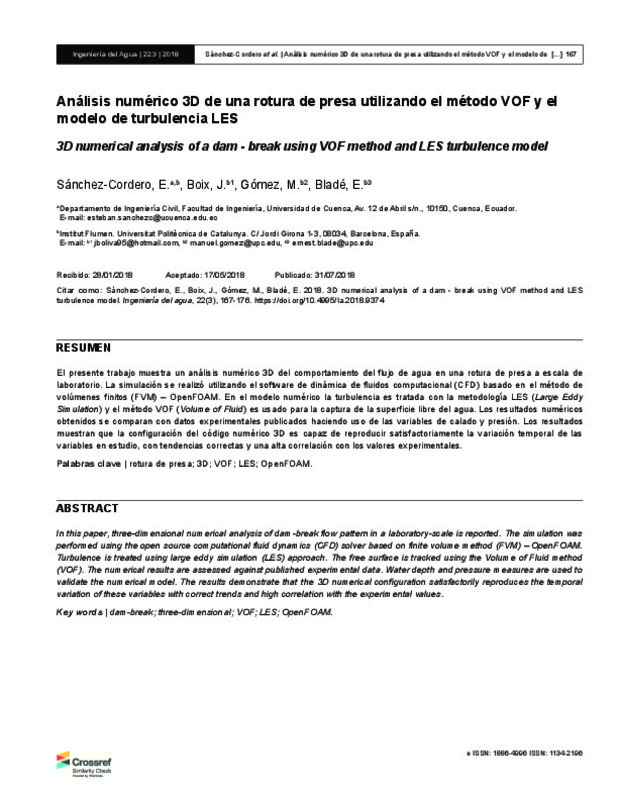Ancey, C., Iverson, R. M., Rentschler, M., Denlinger, R. P. (2008). An exact solution for ideal dam-break floods on steep slopes. Water Resources Research, 44(1), 567-568. https://doi.org/10.1029/2007WR006353
Aricò, C., Nasello, C., Tucciarelli, T. (2007). A marching in space and time (MAST) solver of the shallow water equations. Part II: The 2D model. Advances in Water Resources, 30(5), 1253-1271. https://doi.org/10.1016/j.advwatres.2006.11.004
van Balen, W., Blanckaert, K., Uijttewaal, W. S. J. (2010). Analysis of the role of turbulence in curved open-channel flow at different water depths by means of experiments, LES and RANS. Journal of Turbulence, 11(12), 1-34. https://doi.org/10.1080/14685241003789404
[+]
Ancey, C., Iverson, R. M., Rentschler, M., Denlinger, R. P. (2008). An exact solution for ideal dam-break floods on steep slopes. Water Resources Research, 44(1), 567-568. https://doi.org/10.1029/2007WR006353
Aricò, C., Nasello, C., Tucciarelli, T. (2007). A marching in space and time (MAST) solver of the shallow water equations. Part II: The 2D model. Advances in Water Resources, 30(5), 1253-1271. https://doi.org/10.1016/j.advwatres.2006.11.004
van Balen, W., Blanckaert, K., Uijttewaal, W. S. J. (2010). Analysis of the role of turbulence in curved open-channel flow at different water depths by means of experiments, LES and RANS. Journal of Turbulence, 11(12), 1-34. https://doi.org/10.1080/14685241003789404
Biscarini, C., Di Francesco, S., Manciola, P. (2010). CFD modelling approach for dam break flow studies. Hydrology and Earth System Sciences, 14, 705-718. https://doi.org/10.5194/hess-14-705-2010
Fraccarollo, L., Toro, E. F. (1995). Experimental and numerical assessment of the shallow water model for two-dimensional dambreak type problems. Journal of Hydraulic Research, 33(6), 843-864. https://doi.org/10.1080/00221689509498555
Frazão, S. S., Zech, Y. (2002). Dam Break in Channels with 90° Bend. Journal of Hydraulic Engineering, 128(11), 956-968. https://doi.org/10.1061/(ASCE)0733-9429(2002)128:11(956)
Jones, W. P., Wille, M. (1996). Large-eddy simulation of a plane jet in a cross-flow. International Journal of Heat and Fluid Flow, 17(3), 296-306. https://doi.org/10.1016/0142-727X(96)00045-8
Kleefsman, K. M. T., Fekken, G., Veldman, A. E. P., Iwanowski, B., Buchner, B. (2005). A Volume-of-Fluid based simulation method for wave impact problems. Journal of Computational Physics, 206(1), 363-393. https://doi.org/10.1016/j.jcp.2004.12.007
Liang, D., Lin, B., Falconer, R. A. (2007). Simulation of rapidly varying flow using an efficient TVD-MacCormack scheme. International Journal for Numerical Methods in Fluids, 53(5), 811-826. https://doi.org/10.1002/fld.1305
Liu, X., García, M. H. (2008). Three-Dimensional Numerical Model with Free Water Surface and Mesh Deformation for Local Sediment Scour. Journal of Waterway, Port, Coastal, and Ocean Engineering, 134(4), 203-217. https://doi.org/10.1061/(ASCE)0733-950X(2008)134:4(203)
Moin, P., Kim, J. (1982). Numerical investigation of turbulent channel flow. Journal of Fluid Mechanics, 118, 341-377. https://doi.org/10.1017/S0022112082001116
Salinas-Vázquez, M., Vicente-Rodríguez, W., Chol-Orea, E., Leyva García, V. (2007). Simulación de la turbulencia de un flujo que pasa alrededor de un cilindro de sección cuadrada a partir de la utilización de la simulación de grandes escalas y de fronteras inmersas. Revista Mexicana de Física, 53(6), 461-469.
Smagorinsky, J. (1963). General circulation experiments with the primitive equations. I. The basic experiment. Monthly Weather Review, 91, 99-164. https://doi.org/10.1175/1520-0493(1963)091%3C0099:GCEWTP%3E2.3.CO;2
Stoker, J. J. (James J. (1957). Water waves: the mathematical theory with applications. Wiley.
Stoll, R., Porte-Agel, F. (2006). Dynamic subgrid-scale models for momentum and scalar fluxes in large-eddy simulations of neutrally stratified atmospheric boundary layers over heterogeneous terrain. Water Resources Research, 42, 1-18. https://doi.org/10.1029/2005WR003989
Wu, C., Huang, G., Zheng, Y. (1999). Theoretical Solution of Dam-Break Shock Wave. Journal of Hydraulic Engineering, 125(11), 1210-1215. https://doi.org/10.1061/(ASCE)0733-9429(1999)125:11(1210)
[-]









